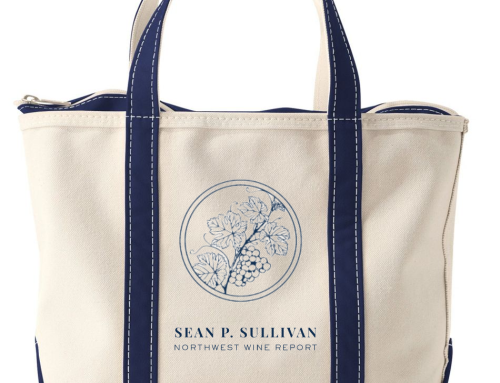Washington will receive its thirteenth federally approved growing region – the Ancient Lakes of Columbia Valley – this week. The appellation is expected to be entered in the Federal Register on Thursday.
Cameron Fries of White Heron Winery petitioned for the appellation along with Joan Davenport, Professor-Soil Sciences at Washington State University. Fries says that he’s been working to gain appellation status for the region for almost seven years.
Fries believes that the Ancient Lakes region deserves to be recognized both for its grape growing and its majestic scenery. “It’s an extraordinarily beautiful area,” he says. “I call it a mini Grand Canyon.” Anyone who has seen a concert at the Gorge Amphitheatre, which lies within the growing region, will surely agree.
Fries says that the hallmarks of the wines from this region are higher acids and higher tannins. Winemaker Freddy Arredondo at Cave B Estate Winery concurs.
“The biggest thing for us is that the wines in general, not just the whites, not just the reds, retain a lot more acidity than in other regions,” Arredondo says. “In terms of the reds, they can also be a bit more tannic.” Arredondo attributes the acids to the area’s cooler temperatures and large diurnal shifts, the tannins to the sometimes windy conditions. He also notes that wines from the area are deeply colored.
The Ancient Lakes area is most commonly referred to as Quincy Basin. However, with Quincy the name of a Loire Valley region, a different name was needed. “The name Ancient Lakes just came to me in the middle of the night one night,” Fries says.
The name Ancient Lake refers specifically to three lakes within the appellation near Babcock Ridge. However, over time, the name has been used more generally to refer to a system of 35 lakes in the surrounding area.
While the federal designation is new, grapes have been grown in the Ancient Lakes area since the 1980s at what is now Cave B. White Heron has vines dating to 1990. In terms of plantings, the Ancient Lakes region is skewed heavily toward white wine grapes, with Riesling and Chardonnay the most planted. However, there are also plantings of Syrah, Pinot Noir, Bordeaux varieties, and other grape types.
Evergreen Vineyard, which encompasses several nearby sites, is both the largest vineyard in the area and the most well known, with vineyard-designated bottles made by Milbrandt Vineyards, Charles Smith, EFESTE, Sleight of Hand, Tempus Cellars, and others. The vineyard is known for its crisp acidity and distinctive minerality with Riesling the most prominent player.
The new Ancient Lakes region contains 162,762 acres of which approximately 1,400 are currently under vine. It is located within the Columbia Valley appellation and includes the towns of Quincy and George. Most of the appellation is within Grant County.
The appellation is bounded by the Columbia River to the west; the Winchester Wasteway, a drainage canal, to the east; the Beezeley Hills to the north and the Frenchman Hills to the south. Elevations range from highs of 1,600 in the north to 1,900 feet in the south with considerably lower lying areas in the middle. The three lakes that comprise Ancient Lake are at an elevation of 821 feet, one of the lowest areas of the appellation. Interstate 90 runs through the middle of the growing region.
There are currently six wineries within the Ancient Lakes appellation: Cave B, White Heron, Ryan Patrick Vineyards, Beaumont Cellars, Jones of Washington (tasting room), and St. Laurent Estate Winery (production facility). Some of these wineries make both estate and non-estate wines.
There are six commercial vineyards dispersed throughout the area. These vineyards belong to: Milbrandt Vineyards (840+ acres), Jones of Washington (334 acres), Cave B (105 acres), Ryan Patrick (58 acres), Sunset Vineyard (40 acres), and Mariposa (12 acres, White Heron).
In terms of soils, the appellation application identifies 65 different soil types, all of which are influenced by the Missoula Floods, consistent with most of Washington’s growing regions. Seventeen of the soil types account for 88% of the overall acreage. According to the application, the most common soils are fine sand, very fine sandy loam, silt loam and loamy fine sand (yes, there are differences between all these things!).
Climatically, the Ancient Lakes is one of the cooler regions in the state, beginning its heat accumulation later and ending it sooner. It is also one of the drier areas, receiving only 6 inches of precipitation annually.
With the appellation’s approval, wineries will be able to submit appellation-designated labels for approval in a month’s time. Consumers can expect to see wines with an Ancient Lakes designation on the shelves in early 2013.
Top picture courtesy of Cameron Fries, White Heron Winery. See additional pictures from the area here.








Can't wait to see how label designers cram that AVA on a label. Great that the area is recognized. Kudos to Dr Dirt (Joan) and Cameron.
Congrats to the good folks in Quincy. A good place to buy many of these wines, as well as other excellent goodies from the region is White Trail farm stand, just west of the Quincy. that's the first place I discovered many wineries there, Milbrandt, Jones of Washington, Beaumont, White Heron
Hooray for AVA's that are known to have high acids, those are the AVA's I like best ; )